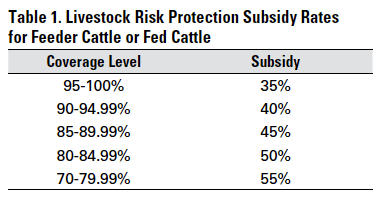Opening Growth Prospective: Bagley Risk Management Approaches
Opening Growth Prospective: Bagley Risk Management Approaches
Blog Article
Comprehending Livestock Danger Defense (LRP) Insurance Coverage: A Comprehensive Guide
Navigating the world of livestock threat protection (LRP) insurance can be an intricate venture for lots of in the agricultural market. This type of insurance policy supplies a safeguard against market variations and unpredicted scenarios that could influence animals producers. By comprehending the ins and outs of LRP insurance, manufacturers can make educated choices that may guard their operations from economic risks. From exactly how LRP insurance coverage functions to the numerous protection choices available, there is much to discover in this thorough guide that might possibly shape the means animals manufacturers come close to threat management in their businesses.

Exactly How LRP Insurance Functions
Occasionally, recognizing the mechanics of Livestock Danger Defense (LRP) insurance coverage can be complicated, yet damaging down how it works can offer clearness for farmers and ranchers. LRP insurance coverage is a threat administration tool developed to secure animals producers versus unexpected price decreases. It's important to note that LRP insurance coverage is not a profits guarantee; instead, it concentrates only on price threat defense.
Qualification and Coverage Options

When it comes to protection choices, LRP insurance policy supplies manufacturers the flexibility to choose the coverage level, insurance coverage period, and endorsements that ideal match their threat management needs. By comprehending the eligibility requirements and coverage alternatives available, livestock manufacturers can make informed decisions to manage risk efficiently.
Benefits And Drawbacks of LRP Insurance Coverage
When reviewing Livestock Threat Defense (LRP) insurance policy, it is crucial for animals producers to consider the benefits and negative aspects inherent in this threat management tool.

One of the primary advantages of LRP insurance policy is its capability to provide defense against a decline in livestock costs. In addition, LRP insurance coverage offers a level of flexibility, enabling producers to tailor coverage degrees and plan durations to suit their particular demands.
One constraint of LRP insurance coverage is that it does not safeguard versus all kinds of dangers, such as disease episodes or all-natural catastrophes. It is essential for manufacturers to very carefully examine their private danger direct exposure and monetary situation to establish if LRP insurance policy is the right threat management tool for their procedure.
Comprehending LRP Insurance Policy Premiums

Tips for Making The Most Of LRP Benefits
Taking full advantage of the advantages of Animals Danger Protection (LRP) insurance coverage calls for strategic planning and positive threat administration - Bagley Risk Management. To make the most of your LRP protection, think about the adhering to ideas:
On A Regular Basis Assess Market Conditions: Remain informed about market patterns and cost fluctuations in the animals sector. By keeping track of these variables, you can make educated choices concerning when to acquire LRP coverage to secure versus prospective losses.
Establish Realistic Coverage Degrees: When picking protection degrees, consider your production prices, market price of animals, and prospective risks - Bagley Risk Management. Setting reasonable coverage degrees makes sure that you are properly safeguarded without paying too much for unneeded insurance coverage
Diversify Your Coverage: As opposed to counting exclusively on LRP insurance coverage, think about diversifying your danger monitoring techniques. Integrating LRP with various other danger management devices such as futures contracts or options can provide detailed protection against market uncertainties.
Testimonial and Readjust Protection Consistently: As market problems alter, regularly evaluate your LRP coverage to guarantee it lines up with your current threat exposure. Changing insurance coverage degrees and timing of purchases can assist optimize your threat security strategy. By complying with these tips, you can make best use of the advantages of LRP insurance policy and safeguard your livestock procedure versus unforeseen threats.
Final Thought
In conclusion, livestock threat protection (LRP) insurance policy is a valuable tool for farmers to take care of the economic dangers connected with their animals operations. By recognizing exactly how LRP works, qualification and insurance coverage options, along with the advantages and disadvantages of this insurance, see this here farmers can make enlightened choices to safeguard their livelihoods. By very carefully considering LRP premiums and carrying out methods to maximize advantages, farmers can mitigate prospective losses and make certain the sustainability of their procedures.
Livestock producers interested in acquiring Animals Danger Defense (LRP) insurance coverage can check out a range of eligibility requirements and insurance coverage options customized to their details animals procedures.When it comes to coverage choices, LRP insurance coverage supplies manufacturers the adaptability to choose the coverage degree, coverage period, and endorsements that finest fit their danger management needs.To comprehend try this site the intricacies of Animals Threat Security (LRP) insurance policy fully, understanding the elements affecting LRP insurance policy costs is crucial. LRP insurance coverage costs are figured out by different aspects, including the insurance coverage degree picked, the anticipated rate of animals at the end of the protection period, the type of animals being insured, and the length of the insurance coverage period.Review and Readjust Protection Frequently: As market conditions change, occasionally evaluate your LRP coverage to guarantee it lines up with your current danger exposure.
Report this page